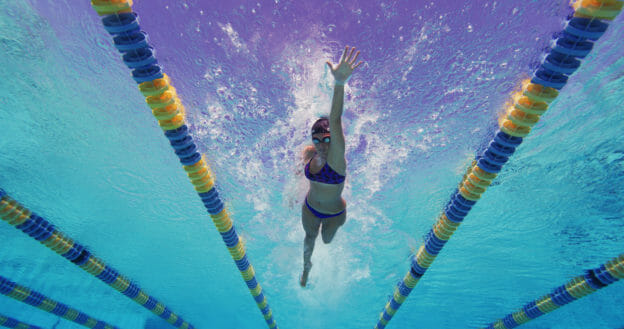Freestyle Flip Turns: Approach
The first of the four parts of the freestyle flip turn is the approach to the wall. The others parts include the flip, underwaters and breakout. As most swimmers approach the wall for a freestyle flip turn, they make the mistake of slowing down.
The slowing of the swimmer can be caused from slowing of the stroke rate, a diminished kick or pull intensity, the distraction of the wall approaching, increased drag caused by lifting the head, or any combination of the above.
Here are five great techniques that will help you improve your approach for the freestyle flip turn.
- Accelerate as you swim toward the wall
Too many swimmers glide into their turns. Once you stop swimming, you start slowing down. Although the ideal last stroke before the turn is a long stroke, even taking a shorter stroke is far better than gliding. Never take a double-arm pull as your last stroke to the wall. That entails using a catch-up stroke, which will slow you down.
There are two ways in which the swimmer can accelerate into the wall – increasing stroke rate or increasing the kick intensity. Of the two, we prefer increasing the kick intensity while holding a more constant stroke rate. Never slow the stroke rate down as you approach the wall.
- Don’t overlook the wall
It is critical that you look at some part of the wall to judge your turn correctly. If you make your turns based only on the T at the bottom of the pool, you will miss your turn 8 out of 10 times. You just don’t have to stare at the Cross at the end of the pool as you approach the wall. That will bring your head way out of the water and slow you down quickly.
We teach our Race Clubbers to look at the lowest black part of the cross, but no higher than that. By doing so, they get a nice reference point for the wall to judge their turn, yet don’t lift their heads far out of the water.
- Don’t take a breath nor rear back as you initiate the flip
If a breath is needed before the turn, the final breath should happen right before the final hand entry, not during the initiation of the flip. Trying to get that last breath in during the flip will cost you in time and accuracy.
Too many swimmers will lift their heads and shoulders up before descending into the flip turn. Respect and take advantage of the law of inertia. A body in motion tends to stay in motion. By rearing back or up, you are heading in the opposite direction that you want to go. Use the momentum of your body’s speed and mass by glancing up at the bottom of the cross, then tucking the chin down when the final hand enters the water. Your speed follows and you will get your feet on the wall faster.
- On your final stroke to the turn, lengthen your stroke and your neck
Ideally, the final stroke to the wall should be a long stroke with a strong kick and no glide. We also like the feeling of lengthening the swimmer’s neck on this final stroke to reach the wall. It makes the turn go better.
- Get yourself into turn shape
There are two ways to look at turns – as a rest station or a work station. Take the first approach and you will get beat on the turns. To swim great races, swimmers need to be in swim shape and turn shape. Turning fast requires a different level of conditioning than turning slowly.
In practice, finesse your turns, starting with an aggressive approach to the wall using these five techniques.
Yours in Swimming,
Gary Sr.

